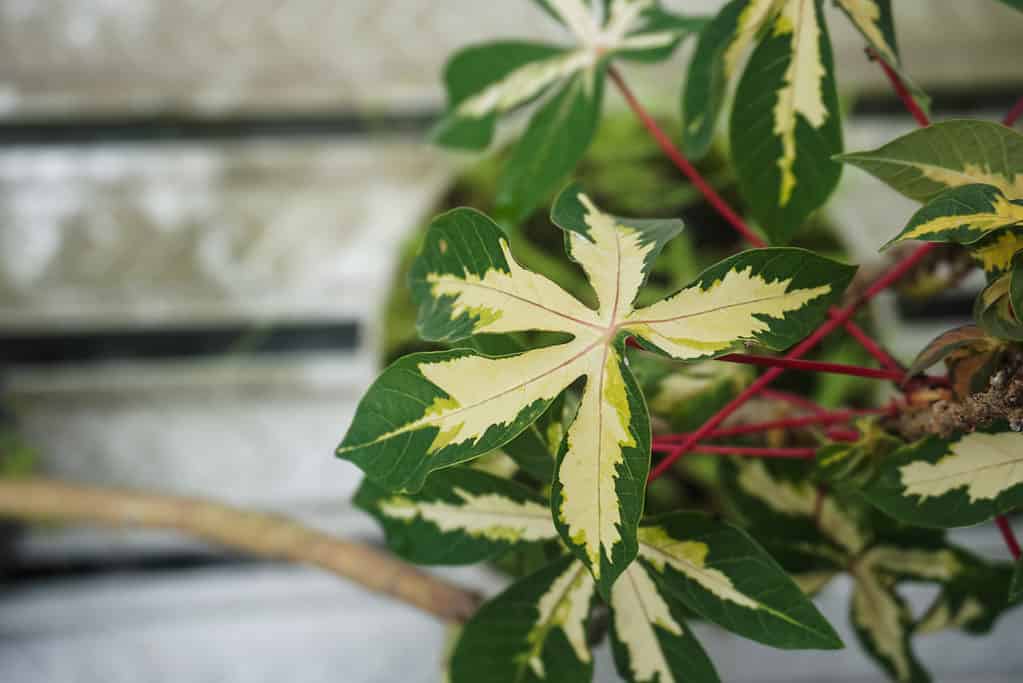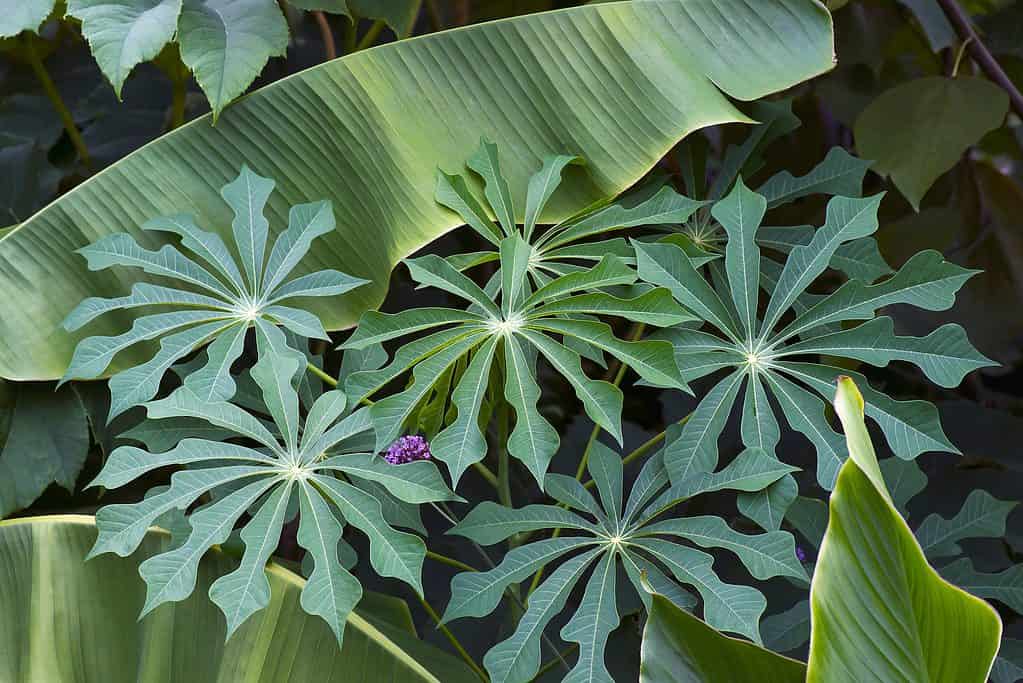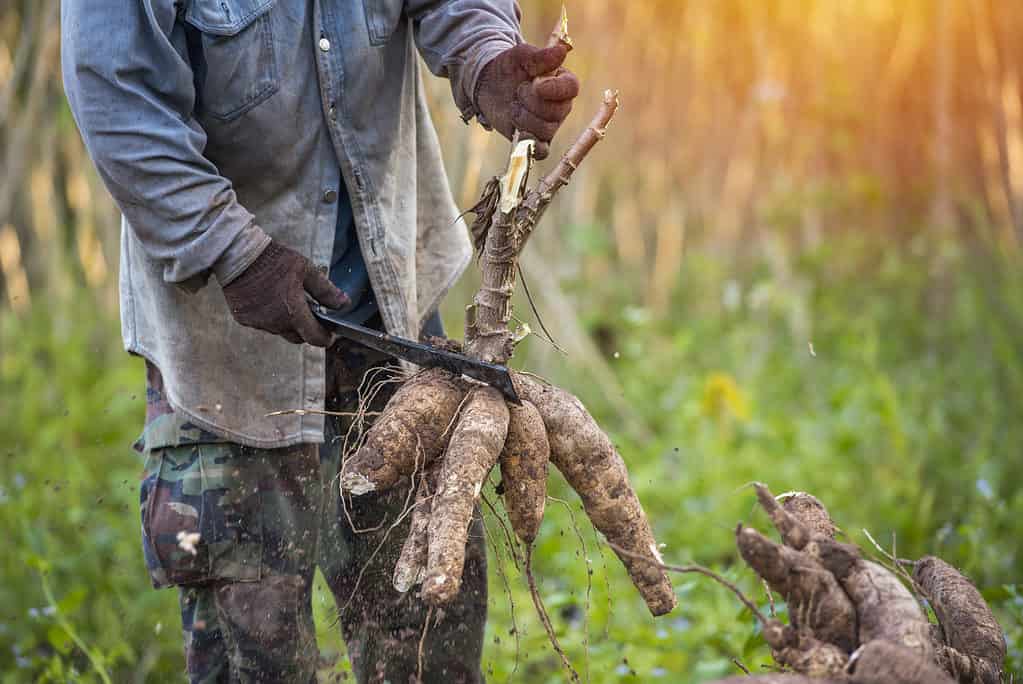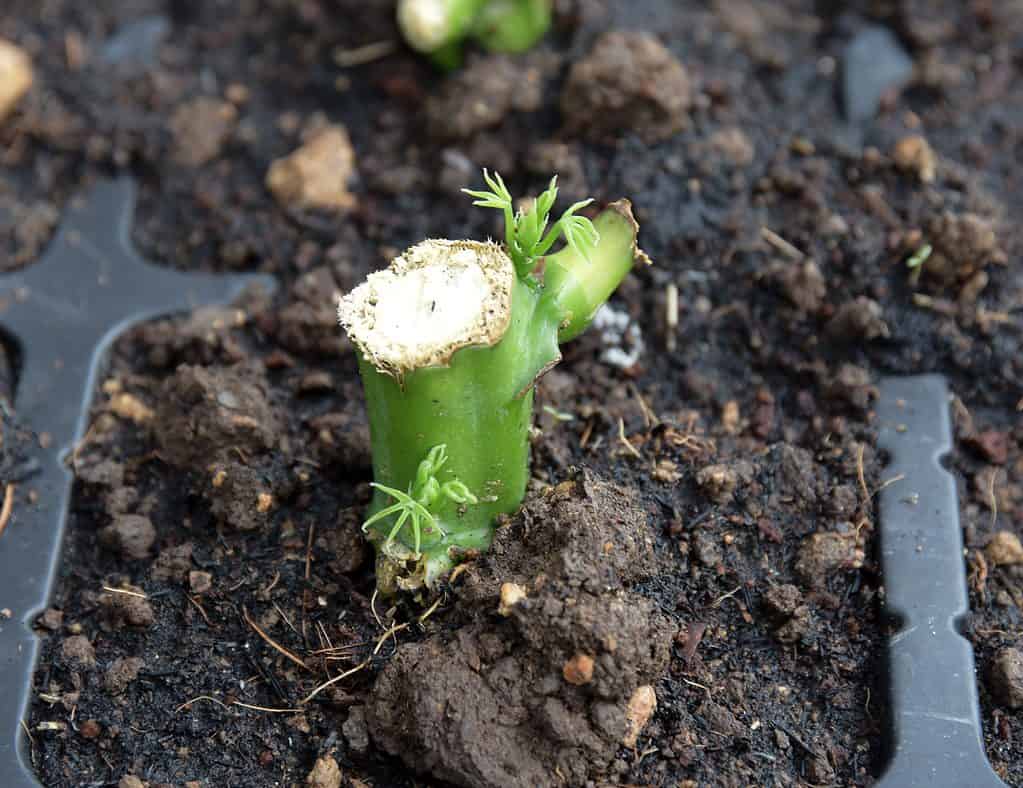Planting flower bulbs in the spring is a common undertaking for many home gardeners. If you live in the warmer climates of the United States and are looking to add some attractive and complex foliage to your garden this spring, growing cassava bulbs might be a good option for you.
| Botanical Name | Manihot sp. |
| Popular Options | Cassava (Manihot esculenta ‘Crantz’), Hardy tapioca (Manihot grahamii), Variegated tapioca (Manihot esculenta ‘Variegata’) |
| Sunlight | Full sun, 6-8 hours per day. Partial shade tolerated. |
| Water | Keep moist throughout the growing season. |
| Soil | Not picky. Well-draining, slightly acidic to slightly alkaline. Looser, lighter soil is preferred if grown for consumption. |
| Hardiness | Perennially winter hardy down to USDA Zone 8. Grow only as summer annual in Zones 6 and 7. |
| For Beginners? | Hardy and beginner friendly |
| Indoors or Outdoors? | Recommended for outdoors only. |
What is Cassava?
In your search for interesting new additions to your garden, you may have come across listings online that offer up cassava bulbs for sale. While it does not produce a bulb, the cassava plant does produce similar underground parts, called tuberous roots, that it uses for nutrient storage. It is primarily these starchy roots for which these plants are grown, but many choose to add them to their garden for their eye-catching foliage as well.
A member of the genus Manihot, this root is one of the top three most important and calorie-dense food crops produced throughout the tropics. It may come as a surprise, then, that all parts of the plant contain the cyanogenic compound prussic acid. You must neutralize it before consumption. Although its root system is poisonous, it does make for a nutritious staple food when properly prepared.
Cassava, also known as yuca, is native to Brazil and is estimated to have been brought into cultivation between 7,000 and 9,000 years ago. It remains widely cultivated today for use in the production of tapioca flour and for bulk sale of its fleshy roots, which are eaten mashed, fried, stewed, or baked into bread and chips. As a result of Brazil’s colonization by the Portuguese, the cassava plant has been spread across the world and popularized not only throughout the tropics and subtropics but also in more northern regions as an imported product and garden plant.
The shrub itself is woody and milky-sapped, producing small, pale green and pink summer flowers that are not particularly eye-catching. While its flowers are inconspicuous, it does produce intricate foliage that can add interest and practicality to any warm-climate garden.

The cassava plant produces tuberous roots that it uses for nutrient storage, which is typically why these plants are grown.
©CHOTE BKK/Shutterstock.com
Growing Cassava “Bulbs” in the Garden
While cassava plants are generally grown as food crops, some people choose to grow them and other members of the genus in home gardens fill out background and midground spaces or draw attention with their intricate leaf shapes and colors. In this context, there are more than one species that may be of interest.
Variegated Tapioca (Manihot esculenta ‘Variegata’)
Featuring bright red stems and deeply lobed, palmate leaves with cream-colored centers and dark green margins, these plants are sure to draw attention. You can grow them in groups and use them to break up walls of solid green foliage or grow singly as accent plants. They are also great candidates for container planting.
The woody, cane-like stalks can quickly reach heights of 3-4 feet throughout the spring and summer growing season but are not winter hardy – unprotected, the plant will die back at least partially during winter in USDA Zones 8 and 9, and may perish altogether if not winterized in areas that experience colder temperatures. It is commonly grown only as an annual in these cooler areas.

‘Variegata’ has bright red stems and deeply lobed, palmate leaves with cream-colored centers and dark green margins.
©iStock.com/bwins29
Hardy Tapioca (Manihot grahamii)
This species is grown primarily in ornamental contexts in North America due to the shape of its stunning foliage. A subtropical member of the genus, Manihot grahamii, is known commonly as the hardy tapioca due to its greater versatility and is root hardy down to USDA Zone 7b. Like its cousin, cassava, this shrub produces very small, inconspicuous green flowers.
Growing to heights of 8-10 feet throughout the growing season, this species bears its incredible foliage atop tall, lanky stalks. Its leaves are very deeply lobed, stretching out from their centers in wide and flat. Delicate rays can be enjoyed from late spring until fall in USDA Zones 9 and cooler. The onset of colder fall and winter temperatures will kill back above-ground parts in these Zones. Further south of that, in Zones 10 and 11, these plants are evergreen perennials.

Hardy tapioca grows 8-10 feet in height and has leaves that are very deeply lobed, stretching out from their centers in wide, flat, delicate rays.
©Nikolay Kurzenko/Shutterstock.com
Cassava (Manihot esculenta, ‘Crantz’)
There are around 100 species in the genus Manihot, and this is the only one that is commercially cultivated. If you’d like to grow a cassava plant for food, this cultivar is the one to choose.
Often treated as an annual regardless of Hardiness Zone, be sure to plan for at least 8 to 12 months of warm-weather growth before harvest. Due to shorter growing seasons, it is not practical to grow cassava plants as a food crop in USDA Zones 7 or cooler.
At the end of the growing season, once the plant is mature, you can pull the starchy roots from the ground. Carefully process them for consumption, you cannot raw. If not eliminated via cooking, the prussic acid contained in the plant can cause cyanide poisoning. Both sweet and bitter varieties of cassava produce the compound. It is found in lower concentrations in the sweet varieties. Its young leaves also contain this cyanide-producing compound but can be eaten once boiled. They are great sources of vitamins A and C.
Store cassava roots with peels intact for up to a week in a cool dry place such as a kitchen pantry. You can also refrigerate once peeled as long as they are in a water-filled container. Change the water out every couple of days. Freezing is your best long-term storage method once your root is peeled, allowing your harvest to stay its freshest for up to 3 months.

Once the cassava plant is mature, the starchy roots can be pulled from the ground and very carefully processed for consumption.
©venusvi/Shutterstock.com
Growing Healthy Cassava “Bulbs”
While these tubers, like many bulbs, are hardy and beginner friendly, it is still important to supply your plant with the specific resources it needs to thrive. We’ll talk a little about these below:
Sun
The placement of new plants in the garden is everything, both aesthetically and to ensure healthy growth. Luckily, these plants are not picky about light when grown as an ornamental. They do well in full sun but tolerate partial shade as well. Remember, if you are intending to harvest your plant for consumption, you will need at least 8 months of warm, sunny weather to ensure proper root development.
Water
Cassava and its cultivated relatives are drought-tolerant. They do not require large amounts of water to succeed in the home garden. These plants develop more robust root systems and fare better overall when the soil is kept moist. Prevent them from completely drying out. This is not a requirement if they are grown as ornamentals. While moist soil is good for your plants, it is crucial to prevent them from becoming waterlogged. Soggy soil and standing water will prevent oxygen from reaching roots and put your plant at risk of developing root rot.
Soil conditions
These plants accept a wide range of soil types and pH levels. They will produce the best growth in near-neutral soils with loamier compositions that are well-draining. Fertilization can be done in spring using a balanced fertilizer. This may not be necessary if your soil contains enough nutritious organic matter.
Soil amendment for consistency reasons is not generally necessary unless your soil lacks drainage or you are intending to harvest the roots for culinary use. In either case, you will want to add more aggregate and composted organic matter to loosen up your soil consistency.
Propagation of Cassava “Bulbs”
Cassava plants are very easy to propagate by planting cuttings taken from mature plants. These cuttings should be around 10 inches in length. Plant them directly into moist potting soil, either upright or laid down horizontally. In either case, embed them at least a few inches into the soil. Take care to keep the soil moist, but not waterlogged. The new plant should develop roots quickly and then transplant into the sunny garden space of your choice!

Cassava plants are very easy to propagate by planting cuttings taken from mature plants.
©kobrunrun/Shutterstock.com
Thank you for reading! Have some feedback for us? Contact the AZ Animals editorial team.








